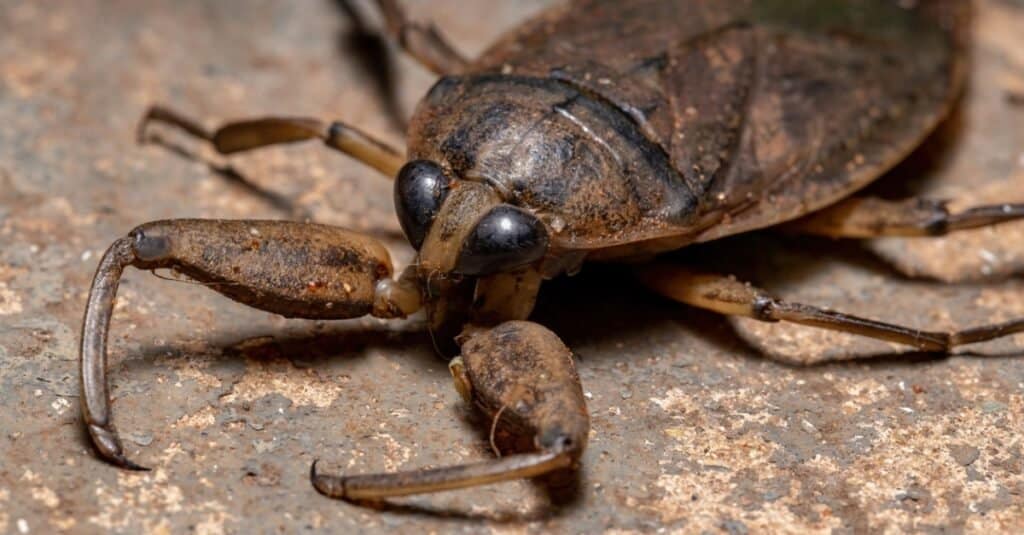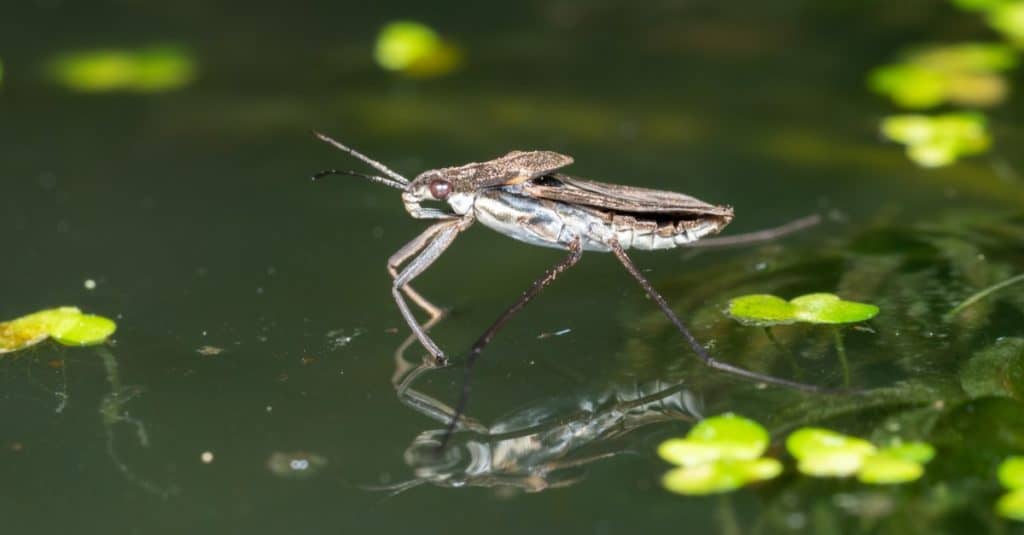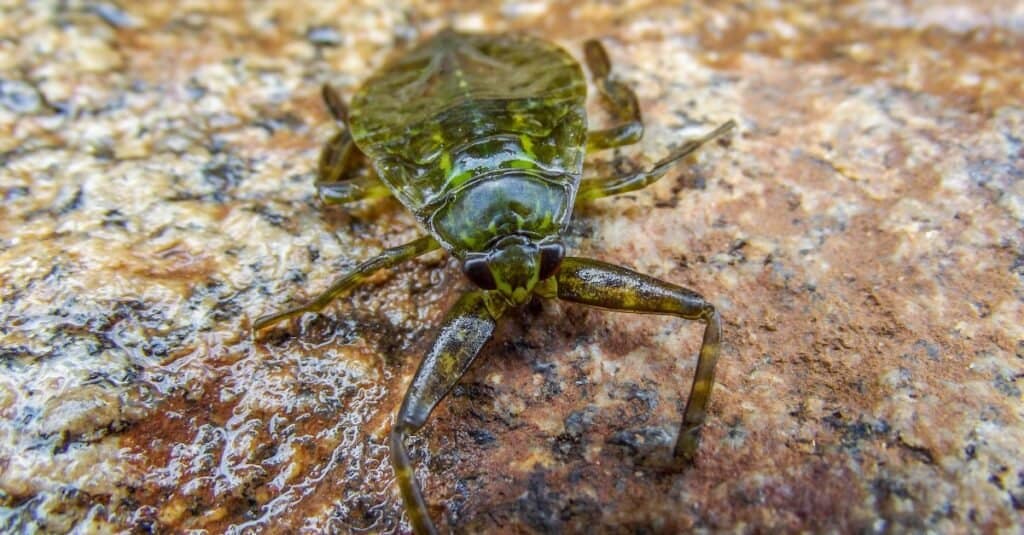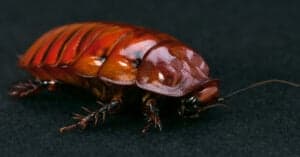This world hosts so many insects and bugs that it’s almost impossible to distinguish between some species! Cockroaches and water bugs are the perfect examples. To the untrained eye, these two bugs look the same. Moreover, some people use the terms “cockroach” and “water bug” interchangeably. But biologically and scientifically, they are two different creatures – starting from being part of different orders and ending with some key dissimilarities in their appearances.
What Are Water Bugs?

Water bugs are the insects in the
Nepomorphainfraorder.
©iStock.com/ViniSouza128
The common name “water bug” refers to various insects. To help you understand what water bugs are exactly and how they’re different from cockroaches, we need to discuss what orders and species bear this name.
First of all, water bugs are the insects in the Nepomorpha infraorder. In fact, the species in this infraorder are generally called true water bugs but can have further naming groupings depending on the species. For example, the insects in the Belostomatidae family are called giant water bugs, while those in the Naucoridae family are called creeping water bugs.
Then, the term “water bug” is used for two types of cockroaches! So that’s where the confusion comes from!
The first species is the American cockroach or the Periplaneta americana. It’s commonly known as a water bug, but it’s not an aquatic species like the true water bug.
The oriental cockroach, or the Blatta orientalis, is also colloquially called a water bug. It has gained this name because it prefers inhabiting dark, moist places. However, oriental cockroaches aren’t part of the Nepomorpha infraorder, like true water bugs. They are part of the Blattodea order, which includes American cockroaches, too.
Now that we’ve cleared this up, let’s see how water bugs differ from cockroaches.
Is a Water Bug the Same as a Cockroach?

A water bug isn’t the same as a cockroach.
©Stephan Morris/Shutterstock.com
No, a water bug isn’t the same as a cockroach.
The first and most important distinction between the two is their scientific classification. While they’re both insects, water bugs are part of the Hemiptera order, and cockroaches are part of the Blattodea order.
Another distinction lies in their lifestyle. While cockroaches can be found near water sources or in moist areas, they do not live in water. Only a few cockroach species habitually go underwater to look for food. On the other hand, water bugs inhabit freshwater environments – they live in ponds, slow-flowing streams, and marshes. Sometimes they can be found in garden ponds or swimming pools.
However, it isn’t easy to spot the differences when it comes to appearance. Water bugs and cockroaches have roughly the same color, with small distinctions. Water bugs are usually brown or grayish, while cockroaches often have a reddish shade, although this highly depends on the species. Another easy way to tell the two apart is by looking at their antennae. Cockroaches have long antennae, while water bugs have short antennae.
Besides this, water bugs can fly. In contrast, while most cockroaches have wings, they rarely fly.
How Do You Get Rid of a Water Bug?
If you notice a water bug, there’s no need to worry because it’s likely a cockroach, not a true water bug. The truth is water bugs aren’t really interested in your home. These insects rarely venture into people’s houses and aren’t considered scavengers. You’d rather spot them in your swimming pool than in your house. And even if they somehow get into your safe space, this would probably be an accident.
Cockroaches, on the other hand, are a completely different “story.” Around thirty cockroach species are attracted to human and pet food, and spotting one or more in your house isn’t a good sign, and you’ll have to get rid of them immediately! These insects are known to carry numerous diseases and cause serious health problems.
Luckily, so many people have dealt with a cockroach infestation that nowadays, you have multiple methods to choose from to kill them! The easiest way is using boric acid. You can sprinkle the powder as it is or add it to mashed potatoes, roll them into small balls, and place them in places cockroaches pass by. However, you should be careful when handling it, as it can harm people and pets.
Further, you can mix baking soda with sugar because baking soda destroys their internal organs and quickly kills them. Unlike boric acid, baking soda is completely safe for kids and pets (unless ingested in large quantities).
If you want to use more powerful insecticides, you can choose among those available on the market.
Bait traps are another excellent way to kill cockroaches. They have entryways with bait in the middle. The cockroach eats the bait, brings traces of it to its nest, dies, and kills its buddies along the way.
Ultimately, seeing a true water bug would be much better than seeing a cockroach!
Incredible Water Bug Facts

Giant water bugs have a very painful bite but are considered safe in terms of toxicity.
©iStock.com/Eric Kukulowicz
If we’ve aroused your curiosity about water bugs, you’ll definitely enjoy reading the facts we’ve selected for you!
- Giant water bugs are the largest in the Hemiptera order and can grow longer than 4.7 inches! They form the Belostomatidae family, and the largest species are in the Lethocerus genus.
- Giant water bugs are a food delicacy in some parts of Asia!
- Water bugs are believed to inhabit Earth for around 250 million years, according to fossil evidence.
- Giant water bugs have a very painful bite but are considered safe in terms of toxicity.
- Many water bugs feed on invertebrates and sometimes even small fish and amphibians. A study shows that a male giant water bug was spotted catching hold of a Chinemys reevesii turtle which had a carapace length of 1.34 inches.
- Water bugs have a rostrum, which they use to suck out fluids from their prey.
- Some water bugs, like those in the Corixidae family, can chew the food and suck up the pulp!
Up Next:
- How To Get Rid of Roaches Overnight
- Bugs That Look Like Cockroaches (But Aren’t!)
- Cockroach Types: The Complete List of Roach Species
- Cockroach Infestation: How to Tell If You Have One (and How To Fix It!)
The photo featured at the top of this post is © iStock.com/ViniSouza128
Sources
- Cockroach Facts, Available here: https://cockroachfacts.com/water-bug-identification/
- Western Exterminator Company, Available here: https://www.westernexterminator.com/cockroaches/cockroach-vs-water-bug/
- Prevention, Available here: https://www.prevention.com/life/a30108414/cockroach-vs-water-bug-difference/
- National Park Service, Available here: https://www.nps.gov/articles/giant-water-bug.htm
Thank you for reading! Have some feedback for us? Contact the AZ Animals editorial team.






